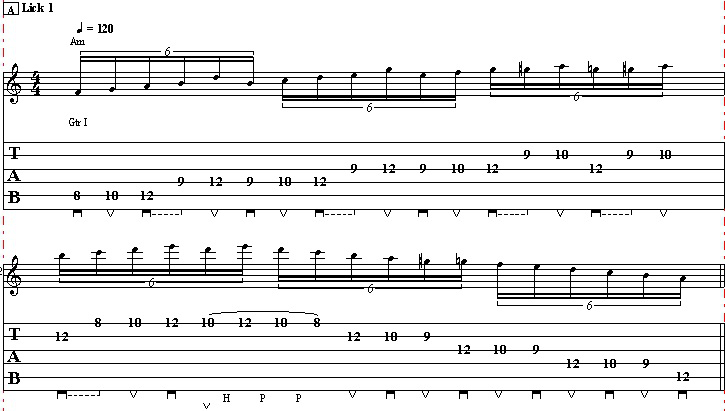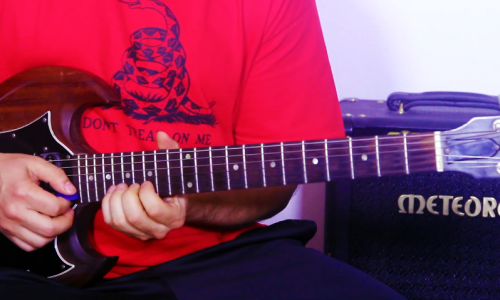Expand your power chord arsenal by Learning How To Play The Zoo Riff By The Scorpions in this free lesson from Guitar Control instructor Darrin Goodman. Be sure to click the link for the free tabs for the Zoo riff.

Introduction
Hey everybody how’s it going? This is Darrin with GuitarControl.com bringing you this video lesson and today I want to show you a couple of things. We’ll be going over one thing, the main riff from the song The Zoo by the Scorpions, I want to use this riff to demonstrate an idea. So basically we want to go over this riff and show some different ways that it could have been played to show kind of like the differences and stuff and hopefully this will give you some ideas of things that you can do to add in like a little harmony into melody lines that you already maybe came up with. So anyhow be sure to click on the link in the description for the tabs and let’s get close up and take a look at this Zoo riff.
The Zoo Riff
All right so the first thing I want to do is just go over this riff for The Zoo. So you’re pedaling the open sixth string; so it’s kind of like a one and two and three and four and one and two and three and four and, like that. So then we’ve got these two note chords and they’re power chords, but they’re not the typical power chords that you usually do.
You’ve probably already done a fifth that looks like this… that’s E5, because I’m on the seventh fret of the A string, which is an E, and then one two three four five up to the fifth note, which is B, so E F G A B, that’s your power chord shape. Or one where you just played on the same fret on two strings at the same time; it’s like… that’s a fourth. So if we look at just the D and the G string open that’s a fourth, so D E F G is four away. So for this what they’re doing is they’re actually doing power chord shapes that are major thirds and minor thirds and what it does is it makes this little melody. So if we just looked at the root notes for this melody… that’s the melody line for it. So on the A string it’s; 12 10 12 10 9 7 9 10. Now if they had taken that and just done the power chords that we traditionally do like a fifth… it sounds considerably different. Now one reason it sounds different is because you’re used to hearing it the way that it’s originally done, so if we look at that little melody line… those are our notes; we’ve got an A G an F sharp and an E, so this is actually in the key of E minor because the notes that are all naturals except one sharp which is F sharp. So what we’re doing is instead of doing the fifths or the fourths we’re doing thirds… So what that’s able for us to do is to have a more pretty sounding harmony instead of just everything being the same because if you’re harmonizing fifths or fourths it’s always the same interval, but here it’s changing from a major third to a minor third. So let’s look at those two shapes for the Zoo riff.
So this first one we’re on the 12th fret of the A string with my third finger in the tenth fret of the D string with my first finger and that is A plus a minor third which is C. So if we look at a chord scale for the key and if you’re not familiar with how to use a chord scale or even what a chord scale is for that matter, I’ll leave a link to a lesson that I did on this that’ll cover all of this, so after you watch that this will make more sense, I’ll just leave a link for that right here. So if we look at the chords in that key, the E chord is minor, the F-sharp is actually a diminished chord, the G is a major and then you have an A minor and an B minor, C major, D major and then back to our E minor again. So that’s how you know which of these notes that you want to use in this key. That A is minor and since this is an A we’re going to do the minor shape and then we go down to a G and in this key G is major so we do our major third shape. So the major third shape is if we’re doing our root note here, we go to the next string and down one fret. So I’m on the tenth fret of the A string with my second finger in the ninth fret the D string with my first finger. Okay so now the next one we go to is F sharp and we’re just doing a minor third; now the chord is actually a diminished chord, but if you look at what the formula for a diminished chord is a minor chord with a flat five, so since we’re not doing the fifths, we’re just doing the third so we can still use our minor shape… Now here its our E minor because we’re here on E on the seventh fret and we’re doing the minor shape because again in that in the key those are the chords. All right, so it’s a cool riff and it’s a good exercise for practicing those shapes because you can mix all of that stuff together using the thirds and the fifths and the fourths and everything. There’s lots of really cool riffs and stuff that you that are based out of that. So something you could do is if we take a melody line and we just played that as single notes around that E it could be kind of like maybe a thrash metal riff… just by playing those notes, those are the notes we were playing for that riff. So if we wanted to do it that way we could mix them together in that sort of a fashion. So you can take just a single string melody line and you can create your own harmony for it or completely change the riff into something else. No one would ever hear this… you can get more mileage out it and make it into other things. Anyway it’s a cool riff and it’s a good exercise for going down through those intervals.
Conclusion
All right, so I hope you enjoyed How To Play The Zoo Riff By The Scorpions and you got something out of it. If you like the lesson be sure to give me a thumbs up. Leave a comment down below if there’s something you’d like to see covered by either myself or one of the other instructors here at GuitarControl.com. If you have not already done so, please subscribe to the channel and click that notification bell so you don’t miss any of the content that we upload throughout the week. Anyway that is all I’ve got for you today. Thanks for watching How To Play The Zoo Riff By The Scorpions and have a great day.



